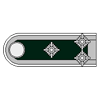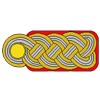Fine lines require these conditions or factors:
1) The AB tip must be very close to the surface.
2) The paint volume being sprayed must be low.
3) The air pressure must be low.
4) Because the air pressure must be low, the paint viscosity (thickness) must be low.
Now, all four of these conditions must be balanced against each other.
For instance, if you move the AB further away from the surface, you'll need slightly more paint and air pressure. Get too far away, and the low viscosity paint will not provide enough coverage (opacity). Etc, etc, etc.
Very, very fine lines on impermeable surfaces (like plastic models) often require multiple passes to achieve coverage because IF you spray too much paint (volume too high) the surface will not "soak up" the excess (like paper used for illustrations or paper towels on your work bench), and the excess paint will run ("spider" or drips).
(Remember the viscosity must be low so opacity is low and only so much pigment is being delivered to the surface.)
Another factor is how fast the paint dries. Using windshield washer fluid to thin Tamiya paint changes this dramatically. The proprietary Tamiya thinners (X-20A or "yellow cap" lacquer thinner) have good drying properties when you start to do more than just basic spraying work. Faster drying paint allows more opacity to build up on the surface before the surface becomes overloaded and the paint runs.
These two thinners can be substituted by isopropyl alcohol (X-20A) or ordinary lacquer thinners ("yellow" cap), since both of those contain the same main ingredients. But other substitutions are a "science fair" project - maybe they'll work or maybe they won't and maybe they wont work all the time.
(I personally use a 50:50 mix of ordinary lacquer thinner and X-20A and then reduce the Tamiya paints by about 50:50 with this. Exact reduction ratios depend on too many things to list here now. But that thinner will reduce Tamiya paints to spray as fine a line as my AB is capable of. Sometimes when the paint viscosity gets very low - ie very high thinner to paint ratios in the 80-90% range - adding back 5-10% Tamiya Gloss Clear X-22 will help reduce spattering from the AB tip and provide smoother coverage. On the other hand, the X-22 will impart an egg-shell satin finish that must be dealt with later. And so it goes... a "balancing act.")
Finally, you're using a double-action AB which requires some skill and practice to balance the paint volume flow (pulling the trigger back) with the air pressure (pushing the trigger down). Since these are two of the four key factors for fine line spraying, the problem MIGHT not be the paint viscosity or the air compressor settings, but AB operator error.
Remember to PUSH the trigger DOWN first then PULL BACK. If you pull back and open the paint flow all the way before you start the air flow, you'll tend to get splatters and drops immediately. The air should be flowing before the paint so that there is enough air pressure and flow at the tip to atomize the paint as the air flow pulls the paint from the tip.
(Remember that after removing the needle for cleaning, when you replace it, push it gently forward all the way into the tip - with the trigger in the full forward position - before you lock the keeper nut. When the trigger is full forward, the paint flow should be completely closed at the tip.)
You don't have to push the trigger all the way down or pull it all the way back. Doing that is no better than a single action AB. This requires practice and experimentation with paint viscosity and air pressure (although trigger control modulates air pressure too). A lot of painters ignore the trigger to modulate air pressure and just set their air compressors to the desired setting and give the AB full trigger all the time.
Even if this is what you do, you should still push the trigger down first before pulling it back. When you pull it back, you can control the paint volume - none, a little, some, a lot.
Again, some painters ignore this too and simply adjust the paint viscosity to match the air pressure on their compressor at full flow on the AB. This is the same as using a single-action AB, but it will work. You just have to learn the viscosity mixes and air pressure combos for your AB.
The entire process is a "balancing act," though, of the the FOUR factors listed above. A lot of this balancing is what works best for you, starting with how you use the AB, then on to what paints and thinners you use.
Try changing thinners and practice correct trigger control with the double-action AB. Learn to move in close, and the closer you get, the less air pressure and paint volume you'll need. When the paint won't flow any more at that range, reduce (thin) it down a bit more and get closer still. It just takes some practice and getting used to your own AB and paints.
Don't give up, though. It's all a matter of logic and problem solving, but remember, each factor (air pressure, paint volume, paint viscosity, and distance/speed) effects the others and each must be balanced against the all.
HTH,








































